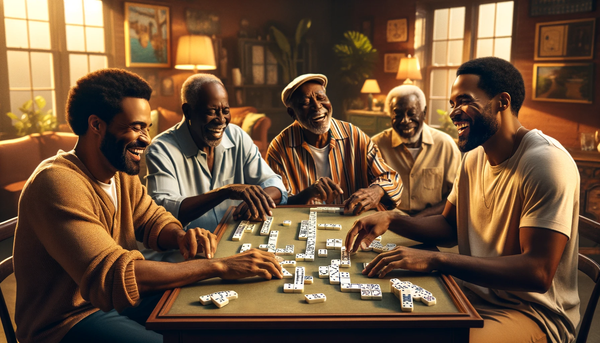Dominoes Guide: Rules on How to Play Dominoes

"Playing Bones" or Dominoes is a classic game that has been enjoyed for centuries by people from all over the world. In this complete guide, we are going to walk you through the essential rules of how to play dominoes, when you're done reading this you'll be ready to jump on the table and start slamming tiles with your family and friends.
If you are a 100% beginner or have some experience playing the game of dominoes, this guide will provide everything you need to become a skilled dominoes player. We'll cover just about everything from understanding the basic moves, setting the game up, and starting to count dominoes and of course score points. So let's dive in and learn how to play dominoes!
Key Takeaways:
In this complete domino guide you will learn the following
- The History of Dominoes
- The basic rules of dominoes
- How to set the game up
- Score your first points
- Start counting dominoes
- Slang terms
- Enjoy and create lasting memories with your friends and family.
Popularity of Dominoes as a Classic Game
Dominoes is a timeless classic game that has gained popularity throughout the years. Bones are loved and slammed by people of all ages, from kids to the elderly, across different nationalities, cultures, and countries.
The simplicity of the game combined with its strategic elements and competitive nature make it a fan favorite. Dominoes can also be played almost anywhere, all you need is table and a set of dominoes.
Giving any setting the potential for an intense game of bones. Don't let an uncle, cousin, or friend talk some trash the dominoes CAN and WILL come out quick. It's so funny I even know a few people who travel with a set in the trunk of their car.
One of the things I love about the game is it's ability to bring people together, especially the generations. My best partner is a guy who is 50 years my senior! Shout out to the legend Joe!
Accessible to People of All Ages

Dominoes can be both a simple and complex game at the same time. Simple in that it only takes matching tiles with the same numbers together, complex in that you have to think plays into the future, and keep track of dominoes that have or have not been played, taking into account behaviors and tendencies.
The simple element makes the game easy for even children to learn and get pretty good at. From my personal experiences, I remember being about 6 or 7 years old and capable of beating a grown adult in a game to 150.
Because Dominoes is easy to learn and understand, making it a great option for intergenerational play. Kids can grasp the rules quickly, while adults can appreciate the strategic elements of the game. Even aging seniors can enjoy the mental stimulation that the game offers, keeping their minds engaged and sharp. I'd be curious to see a mental study on how playing games like chess and dominoes help counteract diseases like Alzheimer's and dementia.
To close this section, dominoes is a game that transcends age barriers and brings people of all generations together. Its accessibility, simplicity, and ability to encourage in person interaction and mental stimulation make it a fantastic game.
History of Dominoes

The precise origin of dominoes are unclear, but it is believed to have originated in ancient China in or around the 12th century. In fact the early sets of dominoes is where the nickname "bones" comes from. The first dominoes were made from ivory and the bones of different animals.
The game gradually spread to other parts of the world, including Europe, where it gained significant popularity during the 18th century.
Today, dominoes remains a cherished game, however there have been a various spins on the game creating many spin offs. Some of these games include: All Fives, Block, Draw, Mexican Train, Moon, 42, Muggins, Chicken Foot and more.
On PlayingBones.com we primarily focus on the all fives version of dominoes. However, we are looking into discussing other games like Block, Draw, and Mexican Train.
Basics of Dominoes
In order to play dominoes, it is essential to understand the basic components of the game and how they contribute to gameplay. Let's take a closer look at the dominoes basics:
- Tiles: Dominoes is played with a set of rectangular tiles, typically made of wood, Ivory, or plastic. Each tile is divided into two squares, or ends, with a line representing the center dividing them.
- Pips: The ends of the tiles are marked with a certain number of pips, ranging from 0 to 6, or they may be left blank. These pips or simply "dots" represent the numerical value of the domino tile and are critical for matching bones during gameplay.
- Suits: Domino tiles are grouped into suits, which are sets of tiles with the same combination of pips. The theory is similar to that of playing cards but instead of diamond or clubs, suits are just the numerical value. For example, a double-six suit consists of tiles with two identical ends that have six dots each. The suits of this domino is 6. However, if the 6/5 domino is of both the 6 and 5 suit. Navigating and counting the amount of suits being used in the game is the key to becoming an expert level player.
- Double-Six Set: A standard set of dominoes consists of 28 tiles, known as a "double-six" set. This set includes all possible combinations of numbers from 0 to 6, this is the set you will use to play all fives dominoes. You do NOT want double nine or double twelves dominoes.
Setting up the Game
Before you can start playing you need to run through the ultra simple game setup. To get started follow these simple steps:
- Pour the dominoes onto your playing surface (hopefully a sturdy table). A bonus tip is to always put your dominoes away face up, this way you can just simple flip the box over to get them all out on the table.
- Next wash those dishes! No, You don't need to go into the kitchen. Washing the dishes just means to shuffle the dominoes on the table. Make sure to do a thorough job. If the bones aren't mixed well players hands will be unbalanced.
- Each player should then draw 7 tiles, depending on who you are playing with some might try to convince you draw 9 dominoes and play Nine Rock.
Once the game is set up and each player has drawn their initial dominoes you'll find out who is going to play first. The starting player is determined by whomever has the largest double domino.
For example, players might say "Big Six to the board" whoever has it plays it and the gam begins. If no one has the double six, double five, four, three, two, one, down to the double blank might be played. If no player has a double the game can be started with the next largest domino.
Rules
The rules of dominoes may vary depending on the region and specific variations being played, but for the game of All Fives the rules are simple.
The main objective is to be the first player to reach the target score of 150 points( Some people play to 250). Within the ultimate goal is reaching the target score, players reach smaller milestones like using all their dominoes in any given hand to secure points left over in their opponents hands. For a detailed explanation on this checkout my YouTube short.
After the first play is made players will take turns (going clockwise) placing dominoes down matching the suits of the open ends on the table. We'll dive into what constitutes a match and what doesn't in the next section.
Matching Dominoes

In the game of dominoes, matching is a crucial aspect that determines the placement of tiles and the flow of the game. To successfully play a domino, players need to understand that only a 3 matches to a 3, and a 4 to a 4, and so forth.
When it comes to doubles or tiles that have the same number of pips on both ends, these match with the singular version. When playing a double, make sure that they are placed perpendicular to the line of play, creating a "T" to the domino line of play.
This strategic placement of doubles allows players to open up more possibilities for their next moves and potentially block their opponents from making certain plays.
The matching rules in dominoes require players to pay close attention to the layout of the board and strategically plan their moves. By understanding these rules and engaging in thoughtful gameplay, players can improve their chances of success and outmaneuver their opponents.
Taking Turns
In a game of dominoes, taking turns is an integral part of the gameplay. Players follow a clockwise or counterclockwise direction, depending on the agreement among the participants. This ensures a fair and systematic progression of the game.
During their turn, a player has two options. They can either play a tile from their hand to the line of play, connecting it to a matching tile, or pass if they are unable to make a valid move. Passing is necessary when a player has no suitable tiles in their possession, and has exhausted the boneyard.
If a player doesn't have a play, they MUST draw a tile from the boneyard. The boneyard is a collection of tiles that have not been distributed to the players at the start of the game. In a 4 player game there won't be a boneyard.
The game continues in this manner, with each player taking their turn in sequence. The turns proceed until one player successfully plays all their tiles or until the game ends with one player reaching the target score.
Sometimes the game gets locked, which is when no more moves are possible for any player. This is a result of all of a particular suit is used, in this case players will tally the total value of the dominoes in their possession. Whomever has the lowest value collects the total bounty from the other players rounded to the nearest five.
Remember this guide covers the very basics of playing dominoes. In later guides and our Beginners Domino Course we dive more into strategy.
FAQ
What are dominoes?
Dominoes are titles with dots on them. These tiles are used to play a classic game that has been enjoyed for centuries by people all over the world. The game of "all fives" is a strategic and competitive game played with 2 to 4 players.
How do I play dominoes?
To play dominoes, all you need a set of bones. From there set up the tiles, shuffle them, draw 7, and take turns placing them according to their suits. The objective is to be the first player to play all their tiles or reach the target score, typically 150, or 250 points.
Can anyone play dominoes?
Sure Can! The game of dominoes is accessible to people of all ages. It can be enjoyed by young kids, adults, and senior citizens. What's awesome about the game is that brings people from all generations together.
What is the history of dominoes?
The exact origins of dominoes are a little cloudy, but it is believed to have originated in ancient China. The game has gradually spread to other parts of the world, including the Caribbean, Asia, United States, and Canada.
How do I set up the game of dominoes?
Before starting the game, place the dominoes face-down on the playing surface. Shuffle them thoroughly, then each player will draw 7 or 9 tiles. Once the game starts players play in a clockwise order.
How do you match dominoes?
Each tile can only be played to connect to tiles with a matching number of dots. Double dominoes like six six are placed perpendicular to the line of play, still only playable on the matching suit, in this example another six.
How do turns work in dominoes?
In dominoes, players take turns going clockwise. Who goes first is determined by who draws the largest domino in the first round, or by who controls the "domino" or the right to play first.





